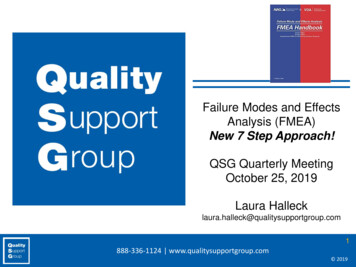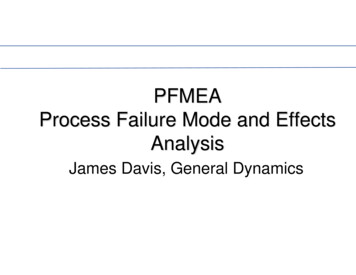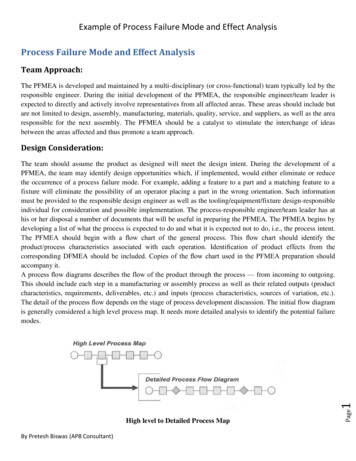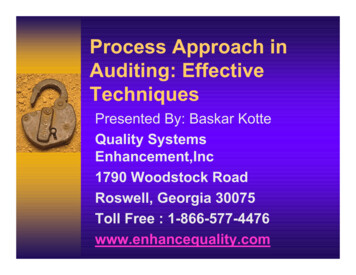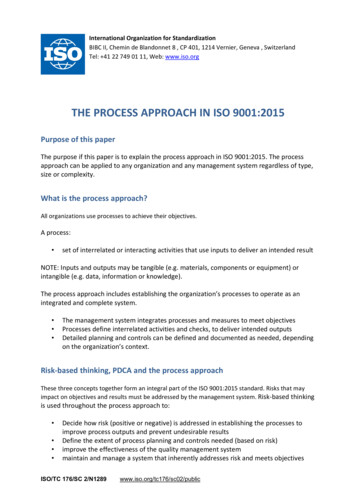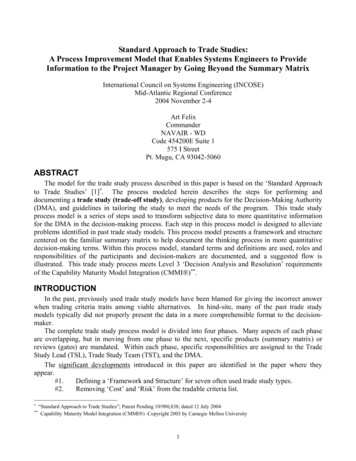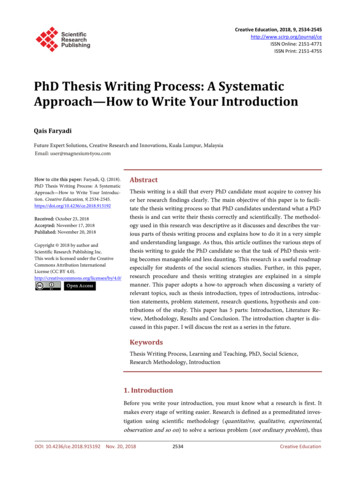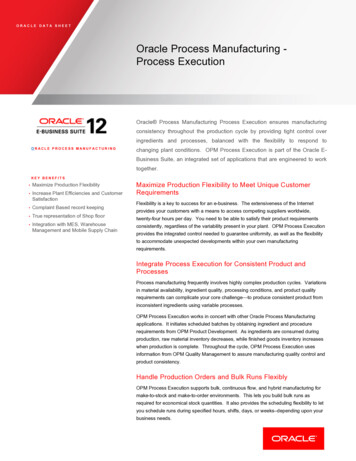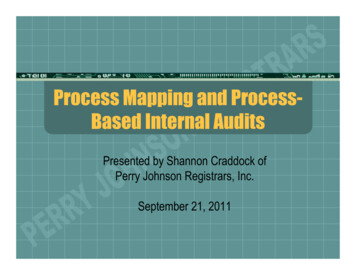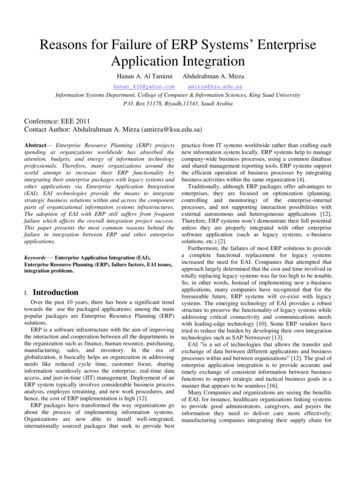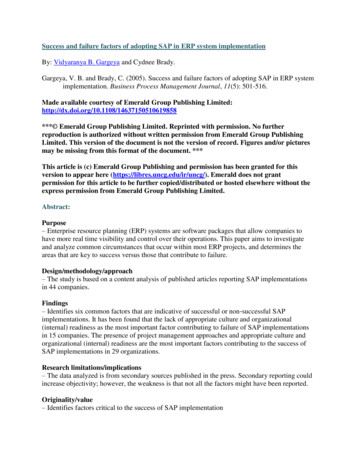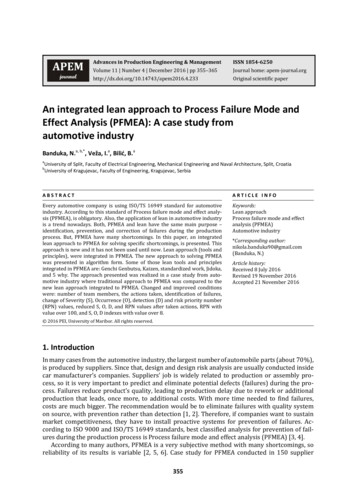
Transcription
Advances in Production Engineering & ManagementISSN 1854‐6250Volume 11 Number 4 December 2016 pp 355–365Journal home: 016.4.233Original scientific paperAn integrated lean approach to Process Failure Mode andEffect Analysis (PFMEA): A case study fromautomotive industryBanduka, N.a, b,*, Veža, I.a, Bilić, B.aaUniversity of Split, Faculty of Electrical Engineering, Mechanical Engineering and Naval Architecture, Split, CroatiaUniversity of Kragujevac, Faculty of Engineering, Kragujevac, SerbiabABSTRACTARTICLE INFOEvery automotive company is using ISO/TS 16949 standard for automotiveindustry. According to this standard of Process failure mode and effect analy‐sis (PFMEA), is obligatory. Also, the application of lean in automotive industryis a trend nowadays. Both, PFMEA and lean have the same main purpose –identification, prevention, and correction of failures during the productionprocess. But, PFMEA have many shortcomings. In this paper, an integratedlean approach to PFMEA for solving specific shortcomings, is presented. Thisapproach is new and it has not been used until now. Lean approach (tools andprinciples), were integrated in PFMEA. The new approach to solving PFMEAwas presented in algorithm form. Some of those lean tools and principlesintegrated in PFMEA are: Genchi Genbutsu, Kaizen, standardized work, Jidoka,and 5 why. The approach presented was realized in a case study from auto‐motive industry where traditional approach to PFMEA was compared to thenew lean approach integrated to PFMEA. Changed and improved conditionswere: number of team members, the actions taken, identification of failures,change of Severity (S), Occurrence (O), detection (D) and risk priority number(RPN) values, reduced S, O, D, and RPN values after taken actions, RPN withvalue over 100, and S, O, D indexes with value over 8.Keywords:Lean approachProcess failure mode and effectanalysis (PFMEA)Automotive industry*Corresponding author:nikola.banduka90@gmail.com(Banduka, N.)Article history:Received 8 July 2016Revised 19 November 2016Accepted 21 November 2016 2016 PEI, University of Maribor. All rights reserved.1. IntroductionIn many cases from the automotive industry, the largest number of automobile parts (about 70 %),is produced by suppliers. Since that, design and design risk analysis are usually conducted insidecar manufacturer’s companies. Suppliers’ job is widely related to production or assembly pro‐cess, so it is very important to predict and eliminate potential defects (failures) during the pro‐cess. Failures reduce product’s quality, leading to production delay due to rework or additionalproduction that leads, once more, to additional costs. With more time needed to find failures,costs are much bigger. The recommendation would be to eliminate failures with quality systemon source, with prevention rather than detection [1, 2]. Therefore, if companies want to sustainmarket competitiveness, they have to install proactive systems for prevention of failures. Ac‐cording to ISO 9000 and ISO/TS 16949 standards, best classified analysis for prevention of fail‐ures during the production process is Process failure mode and effect analysis (PFMEA) [3, 4].According to many authors, PFMEA is a very subjective method with many shortcomings, soreliability of its results is variable [2, 5, 6]. Case study for PFMEA conducted in 150 supplier355
Banduka, Veža, Bilićcompanies from automotive industry shows that the biggest part of surveyed suppliers seesPFMEA as additional administrative work which wastes a lot of time, and gives back less benefits[5]. Obviously it is a problem in misunderstanding or in inadequate use of PFMEA by users.Therefore, there is still lot of space for improvement of this analysis.From the other side, lean was created due to the need for automotive industry to progress.Main purpose of lean was identification, prevention and correction of the problems in industry.Nowadays, a wide application of lean can be found in automotive companies all over the world.From the case study carried out on 300 manufacturers, it is evident that 90 % of them are apply‐ing lean [7]. Also, according to the recent research from 2015 published by Boston ConsultingGroup, 30 % of the world’s original equipment manufacturers use lean tools in their productionsystems [8]. With this data, the theory about wide application of lean approach in automotiveindustry, is confirmed.Since lot of automotive companies are using lean approach and PFMEA for prevention of fail‐ures, methodology for realization of PFMEA with integrated lean approach, will be presented inthis paper. Also, a case study in one specific automotive company will be realized. In a Casestudy, results from reports of already realized traditional PFMEA and new PFMEA with integrat‐ed lean approach, will be compared.2. PFMEA in automotive industryThe main objective of PFMEA is to identify potential failures, evaluate causes and effects of thesefailures, and to propose solutions to prevent these potential failures. The ultimate goal is a fail‐ure‐free product in production process. PFMEA is one of two main types of failure mode andeffect analysis (FMEA). Two main types are defined according to the phase where the productcurrently is. That could be design or production phase. According to this FMEA, the analysis re‐lated to design phase is a Design failure mode and effect analysis (DFMEA) and FMEA related toprocess is PFMEA. One of the differences between these two types is that for DFMEA the enduser is a customer, but for PFMEA it can be the next user in a process. Also, PFMEA is more com‐plicated and time‐consuming then DFMEA. This analysis is a living document, which means thatit have to be upgraded with new information or changed due to changes of product or process.For PFMEA report in automotive industry, a standard report form is usually used. This form isproposed in reference manual by Chrysler LLC, Ford Motor Company, and General Motors Cor‐poration in 2008 [9]. Traditional risk priority number (RPN) is calculated by multiplication ofSeverity (S), Occurrence (O), and Detection (D) as it is shown on Eq. 1. These three indexes S, O,D and RPN are also defined according to standard tables for automotive industry proposed inthe same reference manual. RPN goes from 1‐1000 and S, O, D indexes from 1‐10. Correctiveactions should be taken any time, but especially when RPN exceeds 100 or one of indexes S, O orD exceeds 8. PFMEA is mostly conducted in team, with classic brainstorming technique whilesome standards obligate companies to realize PFMEA reports in a team [3, 4]. (1)In 1973, Ford Motor Company was among the first users of PFMEA in automotive industry forpreventive maintaining quality [10]. Later in the 1990s, PFMEA became the standard practise inmost majority automotive companies and their suppliers, until today. Three most prestigiousautomotive manufacturers from USA (Chrysler LLC, Ford Motor Company, and General MotorsCorporation), set PFMEA as a mandatory to their suppliers in 1990s. Because of this, suppliershad a lot of problems due to the regulations disagreement. So, in 1993 (Automotive IndustryAgency Group) AIAG integrated different FMEA regulations into one uniformed document. Thisresulted with publishing guide reference manual [9, 11]. Today, the fourth edition of this guidefrom 2008 is actual [9]. The Case study from 2003 presented various use of traditional PFMEA inautomotive industry in Europe [5]. Also, in review paper from 2013 a wide use of PFMEA is pre‐sented in industry, especially in automotive industry [6]. This means that a proper use of PFMEAcould be of a great importance for automotive industry.356Advances in Production Engineering & Management 11(4) 2016
An integrated lean approach to Process Failure Mode and Effect Analysis (PFMEA): A case study from automotive industryTraditional PFMEA approach have many shortcomings. Some of these shortcomings wereidentified in the case study realized on 150 automotive supplier companies from United King‐dom and Central Europe [5]. This case study also highlighted main opportunities for improve‐ments: costs, S, O, and D data, technical and resource, standardization, training, PFMEA software.There is also one review paper which highlighted problems related to traditional RPN [6]. Thisstudy shows about 75 articles related to RPN improvements or alternative ways to RPN calcula‐tion. In this paper, various authors were using artificial intelligence, multi‐criteria decision mak‐ing, mathematical programing, hybrid approaches, and other approaches like cost‐based ap‐proaches, Monte Carlo simulations, etc. All these approaches were giving more precise RPN butincreasing time‐consuming of PFMEA realization and therefore were very hardly applicable inreal‐world cases. All these improvements and different approaches are partially solving PFMEAshortcomings which was the biggest problem for its application.Companies have to respond to customers demand fast, with right quality and with acceptableprice. That means that the PFMEA team will not have the time to realize all these complicatedand time‐consuming methods partially. Industry has the need for comprehensive solution whichwill satisfy all three mentioned factors (time, quality, and cost).3. Lean approachLean is American term to describe the Toyota production system (TPS). The advent of TPS isrelated to period after World War II. This Company was in need of a great solution which willturn the company on and make it more competitive on the market. TPS was that solution. Massproduction which was widely used all over the world, was changed with “pull system”, or pro‐duction of the customer demanded products only [12]. Company focus were changed to contin‐uous improvement and quality management in every step. TPS was not famous beside the Toyo‐ta company and its suppliers until 1943, when first oil crisis attacked the world. The most im‐portant fact is that the TPS led Toyota company to the first place on world’s car manufacturerslist. Lean became popular worldwide in the 1990s, when many companies started applying it [13].The lean approach in this paper is approach made of using lean thinking, principles and toolsfor solving PFMEA. Lean principles can be understood best through 4 basic Toyota principles:Genchi Genbutsu (go and see for yourself), Kaizen (continuous improvement), team work andrespect for people, and challenge. Based on this 4 principles, Liker, J. K. [13] preformed his own4 principles known as 4P: philosophy, process, people and partners, and problem solving. Leanapproach could be applied to any other business aspect or in any business situation [13]. Firstly,lean approach have been applied to manufacturing process – lean manufacturing. But nowadays,lean approach is applicable in many other aspects like: lean enterprise, lean office, lean start‐up,lean development, lean system, etc. Lean approach in automotive industry is mostly used forproduction process improvements. For these improvements, various lean tools are commonlyused. For example: Jidoka, Poka‐Yoke, Kanban, single minute exchange of die (SMED), just intime (JIT), 5S, standardized work, 5 why, total productive maintenance (TPM), PDCA, etc.Main purposes of lean are in identifying, preventing and correcting of failures and problems.According to that, lean approach have almost the same purpose in production process as PFMEA.Therefore, there is a lot of space for integration of lean approach in PFMEA for failure preven‐tion improvement.4. Integrated lean approach in PFMEAThis is the new approach in science until now. Various authors conducted several research onsimilar but reverse approach. They were using FMEA as a tool to improve lean system. This isnot necessary, because companies which are using lean approach does not need FMEA to pre‐vent risks and failures. Automotive company is the unique example, because PFMEA is obligato‐ry, with most of them using lean approach also.Shekari, A. et al. [15] were using FMEA as a tool for failure detection to improve lean system.Sawhney, R. et al. [16] presented modified FMEA approach for reliability improvements of leanAdvances in Production Engineering & Management 11(4) 2016357
Banduka, Veža, Bilićsystem. Then, Shahrabi, M., et al. [17] applied FMEA and AHP methods for improvements due tomaintenance of lean system. These papers were related to the use of FMEA in order to improvelean systems. There was one example of using lean tools to improve FMEA. Pavanasvaran, P., etal. [18, 19] used lean tool named Poka‐Yoke to improve FMEA. But this tool was used separately,not as a whole lean approach.Idea is to integrate lean approach into steps to PFMEA realization. But firstly, shortcomingswhich occur during PFMEA realization have to be identified and fixed with lean approach. Formany of these shortcomings various solutions have been already found. For example, for RPN,costs, S, O, D indexes, etc. lot of solutions have been found. But, there is still a lot of space for im‐provements. Specified shortcomings identified in literature, which can be fixed with lean ap‐proach are presented in Table 1. These shortcomings are defined by various authors and theyare presented in the left column. In the right column, the lean approach solutions for fixing ofspecified shortcomings are presented.As it can be noticed, each of the shortcomings is solved with lean approach. Some of the usedlean tools are: standardized work, Kaizen, Jidoka, and 5 why. One of principles used was – Gen‐chi Genbutsu. These tools and the principle will be integrated as a lean approach into PFMEA,resulting with the new PFMEA approach.The new PFMEA approach is proposed in algorithm form on Fig. 1. Proposed algorithm is di‐vided in four phases of Deming’s PDCA cycle for problem solving. Plan (P), do (D), check (C), act(A) is a four‐phase‐cycle for problem solving which Deming pro
similar but reverse approach. They were using FMEA as a tool to improve lean system. This is not necessary, because companies which are using lean approach does not need FMEA to pre‐ vent risks and failures. Automotive company is the unique example, because PFMEA is obligato‐ ry, with most of them using lean approach also. Shekari, A. et al. [15] were using FMEA as a tool for failure .
